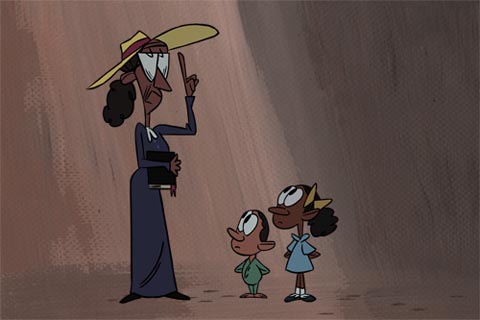

INTERVIEW: How The Rauch Brothers Make Shorts for PBS

Rauch Brothers Animation, operated by Brooklyn-based Mike and Tim Rauch, epitomizes all that is good about New York animation. A couple years ago, they started producing self-funded animated shorts based on audio recorded by the StoryCorps oral history project. These films inspired an entire series of shorts commissioned by the PBS documentary program POV. The Rauch Brothers are now producing their second season of StoryCorps shorts for POV.
I conducted an interview via e-mail with Mike and Tim to learn more about their unconventional background and how their passion project evolved into a full-time job. They will also be presenting their work TONIGHT (4/20) in New York at an ASIFA-East program. In addition to previewing some unaired shorts, they’ll be discussing the process of producing these shorts. The screening begins 7pm at the School of Visual Arts (209 East 23rd Street, 5th Floor, Rm 502). Admission is FREE.
——————————————————
CARTOON BREW: Tell me a little bit about your backgrounds. Neither of you studied animation in school, right?
MIKE RAUCH: We both drew voraciously in grade school, and studied animation and drawing on our own throughout grade school, junior high, and high school. Our teenage brother knew we were into cartoons, and in 1992 he took us to see Beauty and the Beast at a dollar cinema that showed movies after their initial run. When we left the theater, we were both convinced that animation was our future.Â
TIM RAUCH: The more we got to know about Disney animation, the more we came to respect the role of traditional draftsmanship skills in creating hand-drawn animation. Eventually, we discovered the work of Aardman Animations and the film Going Equipped in particular. Seeing an ex-convict tell his life story through quiet, carefully observed acting was very powerful for us and we began to think about using animation to tell stories about the human condition.
MIKE:Â I had dreamed about going to a school like CalArts since the age of 12. However, with six kids to send off, our parents sent us to whatever school offered the most scholarship money. For both me and Tim that turned out to be St. John’s University in Queens. Â
Â
TIM: St. John’s didn’t have any animation courses and the focus was very much on traditional visual arts training. By the time I finally got back around to trying my hand at animation in my senior year, I had spent a good deal of time studying master drawings and sketching people in the subway. As when I was a kid, I was more interested in using small adjustments in posture or little facial ticks to act out a story than bigger, louder movements. With our current work, I am still very interested in these subtleties but we are also beginning to embrace clearer staging and broader acting when it can enhance the story.
MIKE: Self-study and self-directed work has always been a major part of our lives, so we never considered not having a formal training in animation as a limitation. In fact, I think the reverse can sometimes be true. I studied graphic design in college and enjoyed it, but after four years of school I found that all the rules and practices I learned were holding me back. When I sat down to a blank page, there was a war in my head. I found myself overly concerned with the “right way” to do things.
I eventually landed at StoryCorps, where I helped record interviews with everyday people and edit them for radio broadcast. It was a really exciting time for me because I was learning how to shape stories in a much more organic, experiential way than I had learned design. I learned a lot by simply using my ears, my intuition, and then getting feedback from my editor. While I was working for StoryCorps, Tim and I started to work collaboratively, returning to our long-running interest in animation.
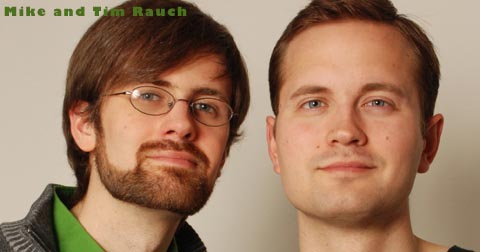
CB: There’s a long line of sibling animation teams that have come out of NY: Evan and Gregg Spiridellis of JibJab fame, Will and Fran Krause, Joy and Noelle Vaccese. At what point did you two decide you were a good fit and wanted to collaborate with one another?
TIM: We’ve been interested in the same things and have shared a very similar perspective nearly our entire lives. Thankfully, we’re also very honest with each other when we don’t agree. That has led to a very unique level of trust, and I don’t think either of us is under any illusions that one could do the same quality of work without the other.
MIKE: I can’t remember a time when we didn’t work together. As kids, we collaborated on every thing from a family newspaper, a storyboard for a cartoon, and several short animations. We’ve also shared many of the same jobs from our first job delivering newspapers, to washing dishes at a restaurant, and more.
Is it easier or more difficult working with a close relative?
TIM: The key to making this work is the right kind of communication and balancing the separation of work and personal life. We have a shared vision and drive that fuels the work, but we also need to be sure we don’t make each other crazy.
MIKE: Being brothers, we’re able to forgive and forget our arguments and speak very directly with each other. Managed correctly, that can make for a really great working relationship. Â
Â
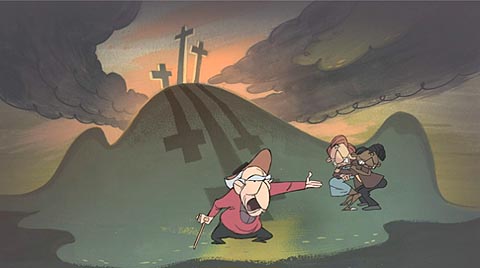
CB: Tim, your drawing style has evolved tremendously since the beginning of the series — your drawings have become simpler and with cartoonier features than earlier pieces, you switched from a thin pencil clean to thick brushy line and from hand-drawn to Flash, and there’s less fully animated acting than in earlier pieces like the Studs Terkel Human Voice piece. How much of these changes have been related to personal exploration and finding a stronger graphic style, and how much of the changes have been about responding to the demands of the software you’re using and the production?
TIM: There have been several factors affecting my style. First, new influences. I tried to pack in everything I knew about the human figure for Germans in the Woods – detailed handling of the ears, the hands, the muscle structures of the human face. I was looking at Rodin and Kollwitz to inspire my approach to the crying soldier, logical influences for an animator with more experience in observational drawing than cartoon shorthand. As I started to get curious about “cartoon draftsmanship”, Milt Gross and Jay Ward took the place of my interest in artists like Hockney and Rembrandt. I had always admired efficiency in drawing and began to understand how that applied to cartoons – clarity of shape and line, contrast of forms in and between characters, simplified levels of detail.
Transitioning from paper to the Cintiq has also affected my style. I used to redraw the entire character for each frame on paper and I figured if I was going to draw a line over and over again I might as well do something with it. The characters were almost never still and while sometimes that’s interesting, it can be distracting. Involved character animation still shows up in the films – Danny’s profession of love in the first shot of Danny & Annie is one good example. But when something less involved is just as good or better, that’s what I use. Studs Terkel happens to have been an extremely expressive person, so with the Human Voice it was important to put that part of his personality across in the animation of his monologue.
The Cintiq has also changed our line quality – I always wanted a stronger, bolder line while working on paper but it was difficult and time consuming to achieve. The brush tool in Flash has been great for quickly getting a punchy line. Finally, going from creating one short per year to seven has had an affect. Besides being personally attracted to efficiency in drawing, I also like to keep up with deadlines and simpler drawing is great for that.
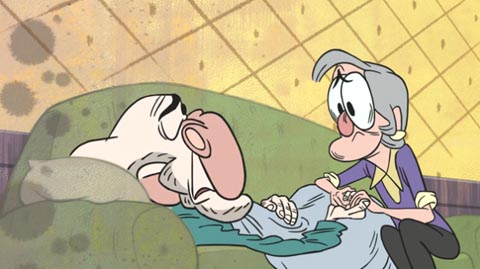
CB: One of the things I like most about your story is that you guys took initiative and made indie animated shorts that ultimately resulted in this series on PBS. That’s very different from the pitching mentality of most industry artists who don’t actually make films and expect to get TV deals. How did your deal with StoryCorps initially come about?
MIKE: We started with Germans in the Woods, and didn’t have any definite intentions of doing more than that, however, when we finished Germans, we were convinced that we had to do a series of StoryCorps shorts. Instead of pitching networks, we needed to pitch StoryCorps. Originally, StoryCorps was willing to give us access to their archive of stories, but they had no interest in getting involved. Without their enthusiastic involvement, we knew the project wouldn’t go anywhere. With them on board, we would have a powerful ally that could play a key role in helping to secure support for a series.
Â
TIM: We would have loved to have been funded from the beginning, but we never let that get in the way of making something we truly believed in. Mike and I decided that we would produce one short per year, and see what happened.
MIKE: When we screened Germans for StoryCorps founder Dave Isay, his first comment after the animation ended was, “This is difficult for me to say as someone from radio, but the animation makes the story better.” We knew we were on to something, but we still didn’t have StoryCorps sold on the series.
We decided that the next short should highlight things that would be important to StoryCorps. It had to show that these recordings were conversations between two people, it had to visually depict the recording booth, and an inter-generational conversation was ideal. Of course, it had to meet the usual standard of making a great cartoon too. That led us to making Q&A, which was the deal-maker for the series. When we showed it to StoryCorps, they were instantly sold. Dave Isay shared Q&A with Pat Harrison, president of the Corporation for Public Broadcasting, which funded the series, and she loved it. A year later we got the green light.Â
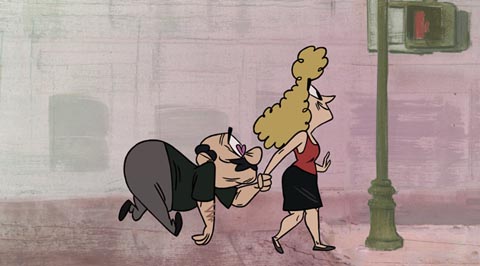
CB: I found it interesting that you hired Los Angeles artists like Bill Wray and Jim Smith to work on the series. Why not choose local New York talent to work on a small-scale production like this?
MIKE: As soon as there was serious talk about a series, we started seeking out lots of information and advice from our friends in animation. One piece of advice we got from pretty much everyone was to hire locally to simplify workflow and communication, and to hire less-experienced, but talented artists who might be easier to mold into our creative vision. We actually heeded that advice, but when the green light for the series came, timing was off and the people we wanted on our team were unavailable. As so often happens on productions, what at first seemed like a disaster turned out to be a boon to the series. On the episodes that we’re currently producing, Bill Wray is working in a style that is more related to his fine art painting than the work he’s known for in cartoons. For us, that has been some of the most exciting work to get back. We believe that working collaboratively like this produces the best results, rather than asking artists to meet some pre-defined style. We want our artists’ hands to show on screen.
Â
TIM: From the beginning, our priority was to find extraordinarily talented artists with strong individual voices. We ultimately decided to focus on what our artists could bring to the project, rather than where they lived and worked. That has made a huge difference for the production.
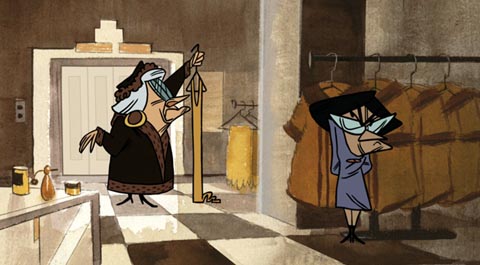
CB: How has the production workflow evolved now that you’re producing a second season of the series?
MIKE: Although still very small, the production team has grown. We’ve added extra animation help so that we can keep pace with deadlines while staying committed to high standards. We’re also planning to bring on some help for character design and storyboard, which we’ve traditionally handled at the director level. We’re excited to have the opportunity to bring somebody in with fresh ideas and new solutions.
As the work gets distributed between more artists and the stylistic approach gets further refined, it has become important to develop tools that new team members can use to quickly find their footing. For example, Tim recently put together a short guide for animators that explains some of the ideas and theories behind the animation style for the series. The challenge now is maintaining an environment that allows the artists freedom to invent and do great work, while ensuring quality and consistency throughout the production.Â
CB: Looking back on the first season, what were the biggest lessons you learned in running a production and/or workflow?
MIKE: The best results are produced when you hire great people, give them plenty of trust and freedom to do good work, and show an openness to their ideas. With this approach, the artists have the opportunity to improve things throughout the process. Plus, demonstrating your trust and respect for your team members’ professional and artistic expertise is one of the surest routes to building a motivated, happy, and healthy team. If the system is more rigid and closed, the artists can start to become closer to button pushers and technicians and the project falls short of its creative potential.
CB: Even in a limited body of work produced to date, you’ve established a unique filmmaking voice. What is your vision for the Rauch Bros. and what sort of projects do you envision yourself working on in the future?
TIM: We aim to tell engaging stories that center around human relationships. We find ourselves most interested in the universal human qualities that can be seen in our everyday interactions with family, friends and neighbors. Collaboration will almost certainly continue to be a part of our work as we find artists from disciplines outside of animation who share our creative goals.
MIKE: We also have a special interest in American stories. We’re currently working on some concepts that center around the Puerto Rican experience in New York City. Longer form storytelling is something we plan to do, and I’m particularly excited about making better use of the possibilities created for animated storytelling in new media. Of course, we hope to continue producing more StoryCorps shorts as well.Â
